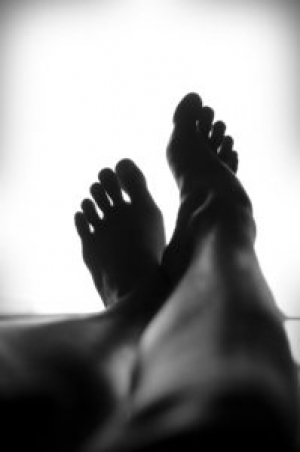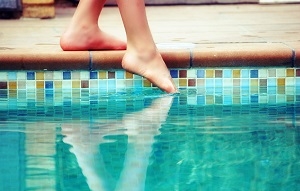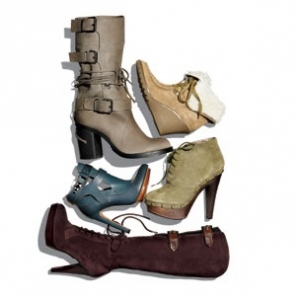Connect With Us
Blogs
ITB Syndrome and how to Care for it
For many runners, hitting the pavement isn’t only a healthy form of exercise, it’s a passion and a way of life. However, no matter what the motivation behind the activity may be, the unfortunate fact is athletes are often prone to an onset of physical complaints, including foot problems, heel pain and other ailments.
Iliotibial Band Syndrome (ITBS), is one of the leading knee injuries that runners experience. It can impact activity levels and lead to disabling pain. Discovering more about this common injury and how to care for it can help keep runners on track…literally.
What is ITBS?
ITB Syndrome involves the iliotibial band, the ligament that runs from the hip to the knee, which helps to stabilize the knee and aid in joint movement. When friction of the ITB band on the side of the knee occurs, the result is inflammation and irritation. This causes sharp pain that is located on the outside of the knee. It may also include the following symptoms:
Swelling around the outside of the knee
Pain that increases with continued running or activity
Feeling the band “snap” as the knee bends and straightens
Feeling intense pains strike when knee is slightly bent
In some cases, pain and tightness at the outside of the hip
What Causes the Syndrome?
Classified as an overuse injury, ITB syndrome is caused by the repetitive bending of the knee. However, there are several different factors that can contribute to the knee pain and increase the chances a person will experience it. Common risk factors include:
- Overpronation of the foot
- Muscle imbalance
- Bowed legs
- Legs that are uneven in length or an uneven running stride
- Wearing worn-out footwear
- Running downhill
- Improper training techniques: too much too soon, insufficient warm-up before activity or not enough rest in between periods of exercise
What Can Be Done For Care & Treatment?
If nothing is done to take care of ITBS, the pain can become chronic and bring activity to a halt. There are several things that can be done to alleviate the pain and prevent the problem from worsening.
Resting is perhaps the most obvious form of care. For runners, it may be one of the most difficult. Running less often and/or shorter distances should be done to allow the ITB band time to heal. However if pain continues, running should be stopped completely, and another treatment pursued. Other methods for caring for ITBS may include:
Ice – Applying ice to the area can help reduce inflammation and pain. This can be done for a length of about 15-20 minutes or until pain diminishes.
Orthotics – Visiting with a podiatrist and possibly having footwear fitted for orthotics can help to ensure proper support.
Stretches – Regularly doing side stretches that stretch the ITB band and hip muscles are helpful for treatment and preventative measures.
Roll It Out – Using a foam roller can work to stretch out the ITB band and act as a deep tissue massage. This can be done by sliding down on one’s side and putting the foam roller under the leg. Next, roll the foam from the hip to the knee using the pressure of body weight.
Strengthening Exercises – Performing lower body exercises like squats and lunges can help build up weak butt and hip muscles. These weak muscles may be contributing factors to the syndrome.
In certain cases, a doctor may recommend additional treatment options such as medication and electrotherapy. Surgery is another option, but it is only performed as a last resort.
The most important thing is that something should be done to care for ITBS in order for runners to once again tackle a path without pain. If you need to be fitted for orthotics, or have another foot issue, contact Super Foot & Ankle Care Center in Long Beach. Our experienced podiatrists and staff are dedicated to helping patients achieve proper foot health in order to get back to being active in the things they love in life.
How to Treat Your Bunions Without Surgery
In terms of leading foot disorders, bunions certainly make the list. This common condition occurs when the big toe joint becomes misaligned and a bump forms at its base. Early on, this deformity can cause a person little to no discomfort, but in more severe cases, bunions can become very painful and interfere with normal day-to-day activities.
While advances in medical techniques have helped bunion surgery make great strides, sometimes more conservative methods can work to provide sufficient relief. These top 4 treatments won’t completely get rid of the bunions altogether, but they can work to ease the pain and prevent the situation from progressing.
Change it Up:
Often, altering your footwear choice is a great initial start for treating your bunions.This generally means avoiding irritation by wearing shoes that are roomy and wide in the toe box, rather than tight or pointed. A knowledgeable podiatrist can help you find appropriate footwear. These shoes not only will offer a better orthopedic fit, but will be better designed or made of materials like soft leather, as to prevent inflaming the bunion.
Protect it:
Moleskin pads and gel guards can work as a type of shield for the bunion, protecting it from agitation and friction. In addition to their pain-relieving qualities, these items can help to prevent the development of corns, calluses and hammertoes, which often can be a subsequent result of the condition.
Support it:
Inserts and orthotics are additional conservative treatments that can provide valuable bunion relief. By redistributing weight, they lessen the pressure that’s placed on the misaligned toe joint. There are several over the counter options available in stores, but for a more customized insert to fit your foot, your podiatrist may prescribe a specific orthotic.
Ice it:
If your bunion is agitated or inflamed, ice can alleviate the pain. Applying ice packs several times a day, for roughly 20 minutes, will work to reduce swelling and discomfort.
Discover the Best Option for Your Bunion
At times, home remedies and conservative treatments can be great avenues for bunion relief. However, as each case is unique, getting the most appropriate care is done after meeting with a podiatrist. At Superior Foot & Ankle Care Center, we view surgery as the last resort, but we also understand the benefits it can offer certain patients. Now that these procedures are performed on an outpatient basis and require less downtime, bunion surgery is easier and far more convenient for patients. Whatever your individual case may be, we will carefully determine the best treatment plan to get your feet back on a healthy track. So, if you would like to discover the best option for your bunion, please schedule an appointment at our Long Beach office today.
Fit Feet for Special Olympics Athletes and Pain Relief Tips
Often times, the importance of keeping feet healthy can get kicked under the rug and then easily forgotten. However, whether you’re going out for a run, shooting some hoops, or getting involved and supporting the Special Olympics, the value of proper foot care comes swiftly into play. While treatment from a Long Beach foot doctor is an appropriate way to ensure your individual needs get met, there are some general steps you can take to leading an active lifestyle with happy, healthier feet.
Lending a Helping Hand to Treat Feet
In the spirit of inclusion, involvement, and fun, thousands of people will come together for the 2015 Special Olympics World Games. With the help of students, residents, and other podiatrists, Dr. Foley of Superior Foot & Ankle Care Center will serve her cause by performing foot screenings on the 7,000 participating athletes from 177 countries. The goal of this service is to ensure each competitor has appropriate shoes and gets foot care advice, in the hopes of keeping their feet and the games going strong.
Foot Screenings Will Focus on These Feet Factors:
- Proper footwear
- Toenail fungus
- Athlete’s foot
How to Handle After-Exercise Foot Pain
Athletes are commonly more afflicted by foot pain, as they rely on their feet to perform. Athlete or not, everyone can use a helping hand in dealing with this discomfort. Try following these 3 helpful tips, the next time you encounter foot pain after intense physical activities:
- Rest & Foot Elevation – While it may not be easy to tell an athlete or heavily active person to give it a rest, that’s just what might be necessary to find a little foot pain relief. Also, as you are in a relaxed position, elevate your feet above the waist to reduce the foot pain and reduce possible swelling.
- Ice – Applying ice is another way to alleviate foot discomfort, decrease inflammation, and numb the aches. This can work to relieve heel pain from a strained plantar fascia, but may be inadvisable for those with diabetes or circulation issues.
- Listen to Your Body – Just like in other areas of the body, if pain persists, your feet are possibly trying to get your attention. Forget the no pain, no gain adage and visit your Long Beach foot doctor. Regular foot check-ups and preventative care measures will help keep healthy feet strong and foot pain at bay.
Consult a Long Beach Podiatrist for Foot Pain Relief
No matter if you are involved in the Special Olympics or not, foot discomfort certainly has a way of getting in the way of exercise and day-to-day activities. The experienced doctors and staff at Superior Foot & Ankle Care Center are dedicated to helping out in the community and helping people everywhere have happy and healthy feet through quality treatment. Feel free to contact our office to schedule an appointment for foot pain relief.
Plantar Fasciitis Treatment: Top 4 Ways to Deal With Heel Pain
Dealing with heel pain can be a real pain in the foot, and unfortunately it’s not uncommon. Affecting many, is a condition called plantar fasciitis, where the tissue existing on the bottom of the foot becomes inflamed and causes sharp, stabbing heel pain. Typically, this pain is strongest when you initially step out of bed in the morning. Plantar fasciitis treatment may be the best solution to handle your foot pain, but it pays off to have your Long Beach podiatrist review your case once pain becomes apparent.
Who’s Most Commonly Affected?
From exercise to work, to our daily activities, we are on-the-go and on our feet. For some, the increased amount of pressure to the plantar fascia tissue can create pain, damage or torn ligaments. Most commonly affected are people who are:
- Overweight
- Runners
- Pregnant
- On their feet constantly at work
How in the Heel Am I to Deal?
Undealt with, it’s possible that plantar fasciitis can eventually alter the way you walk. It can also lead to surgery. However, the good news is that most times it can be treated with conservative methods. Here’s a look at the top 4 steps you can take to help heal the heel pain:
Healing Steps:
- Apply Ice: Several times a day you can ice your feet to decrease the inflammation and reduce the pain.
- Evaluate Your Shoe Choice: Consider the possibility that your shoe selection may not be providing adequate support. By using proper footwear and/or using inserts/custom orthotics, heel pain can be relieved.
- Stretches: Instructed stretches for your Achilles heel and plantar fascia exercises can work to strengthen leg muscles and diminish the pain.
- Visit a Doctor: Often, conservative methods tend to lead to recovery, however if pain persists you should visit a doctor. After an examination, your doctor will evaluate your initial condition and review your options. Treatments may involve medications, various therapies, and in some cases, surgical procedures.
Healed Heels and Happy Feet
With all the hustle and bustle of life, no one wants plantar fasciitis to cross their path. But if you are dealing with this heel pain or discomfort, the dedicated doctors and staff at Superior Foot & Ankle Care Center can help. We see surgery as a last resort and strive to keep feet happy and healthy with educated assessments and preventative care methods. Contact our office today and voice any of your questions or concerns, or schedule an appointment with our podiatrists in Long Beach.
[Photo Credit: Laia Solanellas]
Keeping the Heart Healthy With a Heart Walk
It is no surprise that at Superior Foot & Ankle Care Center we care about feet, but another health concern we hold close to our hearts is heart disease. That is why our team took their feet to the pavement and eagerly participated in the 2015 Orange County Heart and Stroke Walk. This event strove to raise money and awareness for the severity of cardiovascular disease for medical research and for methods of prevention.
You aren’t alone if you didn’t realize the seriousness of this condition, but here are some important facts about heart disease that reveal exactly how concerning it can be.
Facing the Facts about Heart Disease
According to the American Heart Association:
- Heart Disease is the leading cause of death
- Over 375,000 U.S. citizens die from heart disease
- No. 1 cause of death in women
- Every 43 seconds, someone in America is affected by heart disease
- About 635,000 people a year have their first heart attack
Prevention Intervention
These statistics are no doubt alarming to say the least. So, what are a few steps you can take to help prevent heart disease?
Whether you are taking part in a Heart Walk or playing soccer or working out at the gym, physical activity is one important factor in reducing the risk of this disease. Exercising 30 minutes or more a day can manage your body weight and help eliminate conditions such as high cholesterol and high blood pressure that put stress on the heart.
Hand in hand with exercise, is the factor of maintaining a healthy diet. Heart healthy foods like beans, grains, fruits and vegetables are excellent choices. However, foods that are deep-fried or loaded with trans and saturated fats are unnatural and unhealthy. They can increase your cholesterol as well as your chances for a heart attack. Eliminating these food choices from your diet and other health-risks like tobacco, are great ways to prevent heart disease.
Healthy Heart & Happy Feet
These were just a few steps to take to keep your heart healthy. If those steps have literally left you with foot issues or if you are interested in participating in a Heart Walk with us in the future, please contact our foot and ankle care center. We are eager to help you follow the road to better health.
Top Four Tips for Nail Fungus Prevention
Toenail fungus also known as onychomycosis, is a common occurrence among adults. Many people get a nail fungus infection when using public gyms, shower stalls, swimming pools, or even unsanitary nail salons. Nail fungus is an infection that begins as a white or yellow spot under your nail. As the infection continues to grow it can lead to nail discoloration and your nail can begin to crumble. Prevent nail fungus by taking the following precautions:
Visiting a Nail Salon
This is one of the easiest ways to contract a nail fungus infection. There are so many people going in and out of theses shops that it is hard to tell whether the staff is taking proper precautions and sterilizing their tools properly. Prevent toenail fungus infection by taking your own pedicure kit with you when getting a pedicure at a salon protect your feet.
Keep Toenails Dry
Toenail fungus thrives in warm and moist environments making it a bit more difficult to get rid of. Be sure to change your socks frequently, especially after any sports or physical activities. Sprinkle antibacterial foot powder on your toes and shoes to soak up some of the moisture.
Prevent Fungus from Spreading
If you see white or yellowish spots beginning to form, soak your nails to prevent infection. Soak your feet in a mixture of 1 ounce of vinegar and 5 ounces of water, this solution can kill the bacteria that’s forming.
Cutting Nail Incorrectly
It’s important to know what the appropriate length is for toenails and how to cut them properly. Your toenail should line the tip of your toe and should be cut straight across and not round. Cutting them any lower than your normal length can leave your nail beds unprotected leading to a toenail fungus or an ingrown toenail.
Removing toenail fungus is difficult, which is why you should always take the proper precautions to prevent it. If your toenail is completely discolored and unattractive, contact your foot doctor in Long Beach to schedule an appointment to learn about your treatment options.
Why do Bunions Hurt During Colder Weather
Many people who suffer from bunions tell their podiatrist that cold weather makes their bunion hurt worst. There is no evidence that cold weather is what is causing the increase in pain. Rather, foot doctors believe that it is the change in the type of foot wear people use during cold weather that causes the increase in pain.
Most patients seeking bunion treatment are women. During fall and winter, women stop wearing sandals and open-toed shoe styles and start wearing boots and closed-toed shoes. This big change in their footwear can cause irritation to the bunion.
Foot doctor Long Beach recognizes that there is an increase in bunion treatment during cold weather because patients wear shoes that aggravate the joint bursa. Once the joint bursa is aggravated, it becomes red and inflamed, causing the bunion to ache.
Bunions do not go away over time or on their own. Once a bunion forms, it is best to seek bunion treatment from a foot doctor Long Beach. People with bunions will have periods where the bunion does not hurt but over time, the bunion can become irritated and grow. Bunion treatment can be conservative and painless but it is up to the patient to seek treatment. Bunion surgery Long Beach is usually the final answer in safe, permanent bunion treatment.
Women love shoes and during the colder seasons, they seek out stylish boots. Unfortunately, those boots can cause more traumas to the feet. Bunions form on the big toe joint which can be pushed on by tight, ill-fitting, or leather boots. The problems and pain are increased when the boots have a heel. The pain during fall and winter can make some women wish they didn’t have to wear shoes at all.
The pain patients feel from winter style shoes does not just cause more pain now but it can cause bigger bunions over time. Harvard Health Publications urges women to wear the right kind of shoes. If you have a bunion, be mindful of wearing wide shoes with a flexible sole. Heels and boots will not accommodate the bunion and can make mattes much worse.
The bunion surgeon Long Beach patients trust most can discuss your bunion treatment options to begin your road to a bunion pain-free life.
Diabetes and Your Feet – 5 Daily Activities for Standing on Your own two Feet
- Check Your Feet Everyday—During middle of the day, after work, or anytime you come home after being out, check soles for cuts, scratches, blisters, etc. If you can’t see the bottoms of your feet for some reason, then ask for assistance, or use a mirror. Don’t just ignore this daily task.
- Wear Socks and Shoes—Think of socks and shoes like you do the seatbelt in your car. Don’t head out until you know that everything is secure and where it should be. A sock that falls, rubs, or irritates can go unnoticed and end up causing you pain or a trip to the doctor.
- When Wearing Socks and Shoes Choose Comfort—It’s a fact that fashion and function don’t always go together, but when dealing with diabetes, you need to go with what’s comfortable. Don’t wear socks that are too tight, or shoes that cause discomfort.
- Keep Your Feet Squeaky Clean—Take the time to wash your feet every day. This means scheduling time for some foot maintenance beginning with washing. While you’re at it, however, you may as well take the time to trim your nails, carefully smooth rough patches, and whatever else you may be facing.
- Don’t Go Around Barefoot—The National Diabetes Education Program recommends always wearing something on your feet to protect them from hot and cold surfaces as well as potentially stepping on something sharp.
As a diabetic, you’re probably well aware of having the number of a good doctor on hand. Take the extra step and make sure you have a good podiatrist in mind as well. No matter how well you take care of your body, nothing can replace the care of a medical expert.





